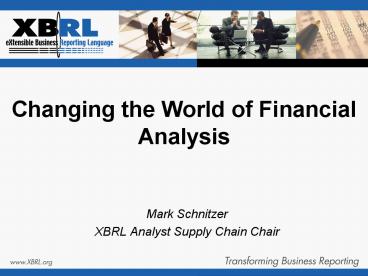Changing the World of Financial Analysis - PowerPoint PPT Presentation
1 / 17
Title:
Changing the World of Financial Analysis
Description:
Analysts do not need to spend time checking the keyed-in data. Web Services Are Critical ... More time can be spent on in-depth analysis. Finding Pension ... – PowerPoint PPT presentation
Number of Views:57
Avg rating:3.0/5.0
Title: Changing the World of Financial Analysis
1
Changing the World of Financial Analysis
- Mark Schnitzer
- XBRL Analyst Supply Chain Chair
2
XBRL will Benefit Companies, Analysts and
Investors
- Timely
- Reliable accurate and well-defined
- Direct from the company
- Machine readable
- Future applications will allow deeper automatic
analysis
3
Why are Investors Interested in XBRL?
- XBRL is useful to us in two ways
- We can integrate the data that we bring in
directly into our models - If the data we send out is in XBRL inside a RIXML
document then it will be easier for our clients
to integrate it with published company data - If companies provide financial information in
XBRL, we will use it
4
How an Analyst Will Use XBRL
- Analysts integrate the data from companies with
information from financial intermediaries
directly into their Excel spreadsheets - Data can be collated and aggregated easily
- Broad surveys can be automated, e.g. pension
analysis - Strategists can aggregate reliable sector and
market data - Sell side analysts can publish to buy side
portfolio managers and analysts in a standard
format using XBRL and RIXML
5
XBRL Will Enable Better Financial Analysis
- Improve data quality
- Direct access to as reported data
- Data validation on entry
- Global access to timely data
- Reduce re-keying of data
- Reduce cost of information
- Enable a new paradigm of financial applications
- Sophisticated analysis
- Should not be apparent to the investor that they
are even working with XBRL
6
Analysts Live in Spreadsheets
- Build a spreadsheet model with historical and
forecasted income statement, balance sheet and
cash flow statement for every company under
coverage. - Model is the basis for valuation and investment
decisions. - Model is used to build investment thesis or
corporate finance decision. - Data from companies is keyed in.
- Analysts incorporate data from multiple data
sources into their models. - Integration of data sources occurs on the
desktop. - Critical data in the model typically comes from
the company.
7
Data Sources
- Financial information providers
- Lack of transparency into as reported data
- Time lag between creation and delivery to market
- Direct from the company
- Discovery of data can be time consuming and
difficult - Inconsistent locations and methodologies
- No guarantee of permanency
- Stock Exchanges
- Tightly coupled with capital markets
- Regulatory repositories
- Authoritative and permanent
8
XBRL Will Improve Models
- Analysts typically type earnings data into
spreadsheet models. - Can take hours to enter data.
- Analysts need to compare analyst forecast,
company earnings release, consensus earnings and
final published earnings. - Time is important.
- Cannot wait for information providers to
distribute data. - Need in time for conference call.
- Error-free data
- Mistakes cost money.
- Analysts do not need to spend time checking the
keyed-in data.
9
Web Services Are Critical
- Moving from document centric electronic paper
world (forms) to virtual documents based on
evolving taxonomies - Mapping of spreadsheets to data sources provides
- Transparency
- Ability to audit
- Ease of discovery
- Alternatives, such as web pages and downloadable
spreadsheets, diminish the value of the data to
the investment community
10
Typical Pensions Project
- Surveyed pension exposure of 250 companies
- 5 companies per day meant 10 weeks initial data
collection - Time from idea to report was too long
- XBRL will shorten time to market
- Near-instant data collection
- Less need to update out-of-date information
- Less intensive data collection means
- More ideas make it into reports
- Shorter turnaround
- More time can be spent on in-depth analysis
11
Finding Pension Information in a Regulatory Filing
12
Advantages for the Analysts
- Faster integration of data into models
- Clearer linkage to source documents
- Fewer data entry and transposition errors
- Greater reliance on the reported data
13
Portfolio Manager/Analyst
- Background
- Deals with vendor-packaged information in
proprietary formats - Still re-keying information into spreadsheets and
databases - Expensive to maintain financial models
- Opportunity for XBRL
- Vendor feeds will be uniform and consistent with
company-provided information - Re-keying will be reduced by reliance on company
tagged information - Integrate analyst forecasts with data from
companies and information providers using web
services
14
Retail Investor
- Background
- Uses popular financial information sites, e.g.
Yahoo - May lack the expertise to process content in
regulatory filings - Need assistance to find critical hints in
reported details and financial footnotes - Opportunity for XBRL
- Provide expert systems to take investor through
key ratios and valuation techniques - Red flag some potential issues
15
Next Generations of Investor Applications
- Will be unlike anything we see today
- Investors today have access to financial
statements but not understanding - Where does an investor find revenue? SPEs?
- What is the difference between revenue and
income? - Investor tools will be more powerful than even
the in-depth analyst models that currently exist - Functionality will be available to all investors
- Insight will become more important than
spreadsheet skills
16
Conclusion XBRL makes markets more efficient
- Better informed investors
- More accessible information for regulators
- Greater access to global markets
- Lower cost of information
- Higher valued added analytics
- More informed investment decisions
- Lower cost of capital
17
Contact Information
- Mark Schnitzer
- mark.schnitzer_at_morganstanley.com































